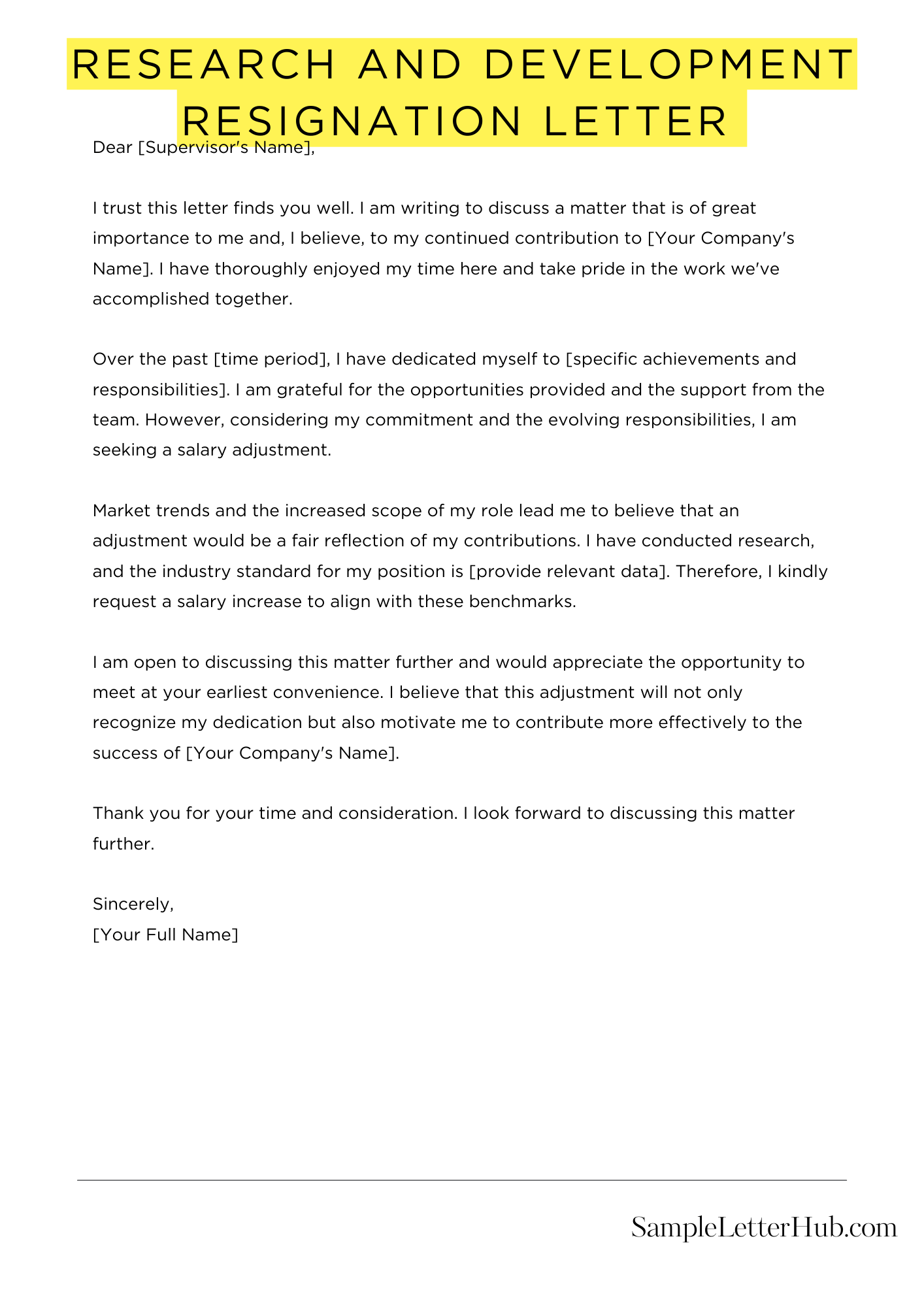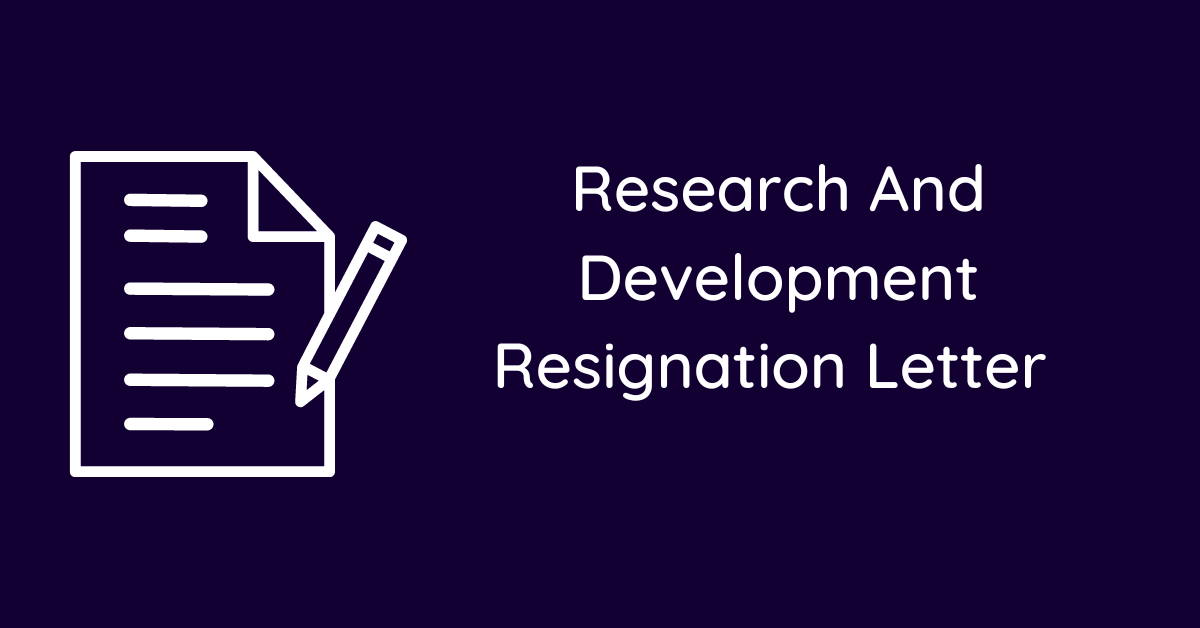A research and development resignation letter is a formal document that you submit to your employer when you are resigning from your position in research and development. In this blog article, we will share an example of a research and development resignation letter with you.
One way to leave a job is to write a clear and professional resignation letter explaining your decision to leave. When writing your letter, be polite and humble in your tone. Thank your employer for the opportunity to work in research and development and express your appreciation for their support.
Below, we have shared a template/example research and development resignation letter that you can use. Feel free to adapt it to your own needs.
Research And Development Resignation Letter
Dear [Recipient Name],
Please accept this letter as formal notification that I will be resigning from my position as a Research and Development Scientist at [Company Name], effective [Last Date of Employment].
I have enjoyed my time at [Company Name] and am grateful for the opportunities I have been given. I have learned a great deal and have made valuable contributions to the team.
However, after careful consideration, I have decided to pursue other opportunities that are more aligned with my current career goals.
I would like to express my sincere appreciation for the support and guidance I have received during my tenure. I wish you and [Company Name] all the best in the future.
I am committed to ensuring a smooth transition during my departure and will do everything I can to assist in any way possible.
Thank you again for the opportunity to work at [Company Name].
Sincerely,
[Your Signature]
Short Research And Development Resignation Letter Sample
Please accept this letter as formal notification that I am resigning from my position as Research And Development at [Company Name]. My last day of employment will be [Your Last Day]. Thank you for the opportunity to grow and learn during my time here. I wish you and the company continued success. I am happy to assist in the transition process to ensure a smooth handover of my responsibilities.
I wish you all the best with your research and development resignation letter.
When it’s time to say farewell, expressing your gratitude and best wishes can make the transition smoother:

How to Write a Research and Development Resignation Letter
1. Start with a Formal Introduction
Begin your letter with a formal salutation, such as “Dear [Manager’s Name].” Clearly state your intention to resign from your position as a Research and Development professional.
2. Express Gratitude and Appreciation
Take a moment to express your gratitude for the opportunities and experiences you’ve gained during your time at the company. Mention specific projects or initiatives that you’re particularly proud of.
3. State Your Reasons for Leaving
Be honest and professional when stating your reasons for leaving. Whether you’re seeking new challenges, pursuing higher education, or relocating, explain your decision in a clear and concise manner.
4. Offer to Assist in the Transition
Demonstrate your commitment to the company by offering to assist in the transition process. This could involve training your replacement, providing documentation, or offering support in any other way possible.
5. End with a Positive Note
Close your letter with a positive and professional tone. Express your well wishes for the company’s future and thank your manager for their support and guidance.
6 Most Frequently Asked Questions About Research and Development Resignation Letters
When it comes to leaving a research and development (R&D) position, it’s important to do so professionally and respectfully. A well-written resignation letter can help you maintain a positive relationship with your employer and colleagues. Here are the six most frequently asked questions about R&D resignation letters, along with their answers:
1. What should I include in my resignation letter?
Your resignation letter should include the following information:
- Your name and contact information
- The date
- The name of the person you are resigning to
- A statement that you are resigning from your position
- Your last date of employment
- A brief statement of appreciation for the opportunity to work at the company
2. How should I format my resignation letter?
Your resignation letter should be formatted in a professional business letter format. Use a standard font, such as Times New Roman or Arial, and 12-point font size. Left-align your text and use single spacing.
3. What should I say in my resignation letter?
In your resignation letter, you should be clear and concise. State your intention to resign and provide your last date of employment. You can also include a brief statement of appreciation for the opportunity to work at the company.
4. Do I need to give a reason for leaving?
No, you are not required to give a reason for leaving in your resignation letter. However, you may choose to do so if you feel comfortable. If you do decide to give a reason, be brief and professional.
5. What if I’m not sure what my last date of employment will be?
If you are not sure what your last date of employment will be, you can state that you will provide it as soon as possible. You should also be prepared to negotiate your last date of employment with your employer.
6. What should I do after I submit my resignation letter?
After you submit your resignation letter, you should meet with your manager to discuss your departure. Be prepared to answer any questions they may have and offer to help with the transition. You should also take this opportunity to express your appreciation for the opportunity to work at the company.
Before making the decision to resign from your job, it’s essential to consider the legal aspects:
Understanding your emotions after quitting your job is important. Explore why you might be feeling sad:
Related
- Resignation letter sample
- Forced resignation letter
- Resignation letter due to going abroad
- Resignation letter due to marriage
- Resignation letter due to other opportunity
- Resignation letter due to mistake

